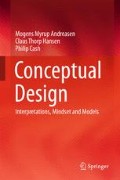Abstract
The design activity is normally based on perception of human needs. However, other factors from the designer’s exploration or imagination might provide the initiator and driver. In this chapter, we discuss the front end of innovation based on awareness and imagination in our Exploration Design Model.
Access this chapter
Tax calculation will be finalised at checkout
Purchases are for personal use only
References
Alger JRM, Hayes CV (1964) Creative synthesis in design. Prentice-Hall, Englewood Cliffs, NJ
Altschuller GS (1987) Creativity as an exact science: theory of the solution of inventive problems, 2 edn. Gordon and Breach, Philadelphia
Andreasen MM, Hein L (1987) Integrated product development. IFS Publications/Springer, Berlin
Andreasen MM, Tjalve E, Stahl H (1973) Konstruktionsprocessens faser (The phases of the engineering design process). Compendium Technical University of Denmark, Copenhagen
Asimow M (1962) Introduction to design. Prentice-Hall, Englewood Cliffs NJ
Beyer H, Holtzblatt K (1998) Contextual design—defining customer-centered systems. Morgan Kaufmann publishers, San Fransisco
Cross N (2008) Engineering design methods. Wiley, Chichester, GB
Dylla N (1991) Denk- und Handlungsabläufe beim Konstruiren. Carl Hanser Verlag, München
Dym CL, Little P (2000) Engineering design—a project based introduction. Wiley, New York
Gish L, Hansen CT (2013) A socio-technical analysis of work with ideas in NPD: an industrial case study. Research in engineering design, ISSN 0934-9839, 24:414-427, doi:10.1007/s00163-013-0159-z, 8 July 2013
Glegg G (1969) The design of design. Cambridge University press, Cambridge
Gordon WJJ (1961) Synectics: the development of creative capacity. Collier, New York
Guilford JP, Hoepfner R (1971) The analysis of intelligence. McGraw-Hill, New York
Harrisberger L (1966) Engineersmanship: a philosophy of design. Brooks/Cole, Belmont, CA
Keinonen K, Takala R (eds) (2006) Product concept design—a review of the conceptual design of products in industry. Springer, Berlin
Koen PA. (2004) The fuzzy front end for incremental, platform, and breakthrough products. In: PDMA Handbook of New Product Development, 2nd edn, pp 81–91
Koller R (1979) Konstruktionsmethode für Maschinen-, Geräte- und Apparatebau (design method for machine, device and apparatus construction). Springer, Berlin
Lehtonen T, Juuti T, Oja H, Suistoranta S, Pulkkinen A, Riitahuhta A (2011) A framework for developing viable design methodologies for industry. In Culley SJ et al (eds) 18th international conference on engineering design, impacting society through engineering design, design society
Markussen TH (1995) Et teoribaseret handlingsgrundlag for betjeningsdesign (A theory based action plan for interaction design). Ph.D. thesis, Technical University of Denmark, Copenhagen
Maslow A (1943) A theory of human emotion. Psychol Rev 10(4):370–396
Osborne AF (1963) Applied imagination—principles and procedures of thinking. Schribners, New York
Pahl G, Beitz W (2007) Engineering design: A systematic approach. Springer, London
Pugh S (1991) Total design—integrated methods for successful product engineering. Addison Wesley, Wokingham
Restropo J (2004) Information processing in design. Ph.D. thesis, Delft University of Technology, Netherlands
Roth K (1994) Konstruieren mit Konstruktionskatalogen (designing with design catalogues). Springer, Berlin
Thomas RJ (1993) New product development—managing and forecasting for strategic success. Wiley, Hoboken, NY, pp 50–57
Tjalve E (1979) A short course in industrial design. Newnes-Butterworths, London. (Facsimile edition 2003) Systematic design of industrial products. Institute of Product Development, DTU Copenhagen
Ulrich KT, Eppinger SD (2004) Product design and development, 3rd edn. McGraw-Hill/Irwin, New York
Wallace PJ (1952) The technique of design. Pittman, London
Author information
Authors and Affiliations
Corresponding author
Rights and permissions
Copyright information
© 2015 Springer International Publishing Switzerland
About this chapter
Cite this chapter
Andreasen, M.M., Hansen, C.T., Cash, P. (2015). Exploration. In: Conceptual Design. Springer, Cham. https://doi.org/10.1007/978-3-319-19839-2_6
Download citation
DOI: https://doi.org/10.1007/978-3-319-19839-2_6
Published:
Publisher Name: Springer, Cham
Print ISBN: 978-3-319-19838-5
Online ISBN: 978-3-319-19839-2
eBook Packages: EngineeringEngineering (R0)

